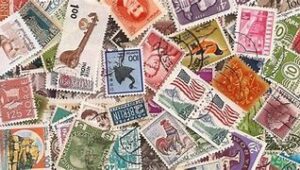John Lowe of MoneyDoctors.ie, explains how the humble postage stamp delivers returns that can’t be licked.
On 1st March 2022 the first class postage stamp rate was increased to € 1.25 for a standard letter, but someday in the future those very stamps may be worth keeping as an investment. You may be thinking that stamp collecting is a pointless, unexciting – even dull – hobby but you’d be wrong. Quietly, as befits such a sedentary pursuit, philately has emerged as one of the hottest and most fashionable pastimes in the world. Postage stamps are the third largest category traded on eBay and it is estimated that over 30 million people now count themselves as active collectors. Much more to the point, stamps have proved to be an excellent medium to long-term investment with average returns not so dissimilar to property or stocks and shares. With all that is going on in the world currently, this alternative form of investment has also many benefits for inclusion in a balanced portfolio.
In terms of weight, stamps are the most valuable commodities you can buy. A well-balanced collection of stamps won’t, obviously, produce an income but should provide substantial capital growth. Two market indices – the SG100 Stamp Price Index and the GB30 Rarities Index – offer tangible evidence of this. Both track average prices and have shown annual increase of closer to 9.5% over the last 10, 20 and 50 years. Furthermore, postage stamps have always fared well in times of economic uncertainty. If you study the performance charts for the last five decades you will notice that there are no dramatic market corrections. Prices may be stagnant for periods – but they rarely fall.
There are four reasons why stamps make such a sound investment. The first is growing demand. This comes from various sources including:
- An aging population in the developed world with the income and time to devote to a hobby such as stamp collecting.
- Rapidly expanding interest in countries experiencing new levels of wealth such as Brazil, Russia, India and China (the BRIC countries – though how long will Russia remain in this acronym ?)
- Investors who use stamps as a hedge against risk. A good example of this was before China took over Hong Kong when wealthy Hong Kong residents bought stamps because they were portable and valuable.
The second is, undoubtedly, the scarcity of supply as clearly there is a limited number of any given stamp in existence. Thirdly, the market is international and liquid. This is all the more true thanks to the Internet, which allows collectors to buy and sell quickly and easily. Fourthly, with astute buying it is possible for the enthusiastic philatelist to beat the market indices and produce even higher returns.
How should you set about investing in stamps? It would be unwise to start without familiarising yourself with the history of the postal service and postage stamps. You would also be well advised to understand how stamps are valued as well as how to care for them. Finally, you should consider what sort of collection you want to build up. Are you interested in stamps from a particular country, airmail stamps, stamps that deal with a particular subject? Would you be more interested in covers (where the stamp is still attached to the envelope) or unused stamps or commemorative issues?
One area of obvious interest to readers of this paper is that of collecting Irish stamps. Between 1840 (when the first of 72 million ‘Penny Blacks’ were printed in the UK) and 1922, we used British stamps, which are referred to as ‘GB Used in Ireland’. The most sought after stamps for Irish collectors were the British stamps that were overprinted for Irish use first printed in February 1922 and the last one in 1935. Between 1922 and 1984 Ofig an Phoist took responsibility for printing stamps, after which it passed to the newly created An Post. The 166 years of post in Ireland offers hundreds of collecting possibilities such as the 1865-67 Fenian issue, produced by Irish veterans of the U.S. Civil War but never put into use due to the failure of the Fenian uprising. There was also the banned ‘propaganda labels’ issued between 1907 and 1916 by Sinn Féin; and as already stated, overprinted British stamps used as a temporary measure by the Rialtas Sealadach na hEireann (Provisional Government in Ireland) in 1922.
For further information on Irish stamps, you could contact An Post :
- An Post – The Irish Post Office http://www.anpost.ie/AnPost
- An Post – Philatelic Services http://www.irishstamps.ie/IrishStamps/
Whatever area you decide to invest in, a stamp collection should deliver returns that are difficult to lick.
Top philately investment tips
– If you are buying for investment purposes take specialist advice from an auction house, dealer or experienced philatelist.
– Before you buy determine your investment objectives and decide on a strategy. It is sensible to build up a diversified portfolio of stamps in the same way that you would build up a diversified portfolio of shares.
– A low risk strategy would be to collect in a well-established, popular area – avoiding anything that might be prone to speculative influences.
– A higher risk (and potentially higher return) strategy would be to anticipate future demand. For instance, you might decide to invest in stamps from an emerging economy where stamp collecting is still in its infancy.
– If you become passionate about philately then you could try to corner a new market and thus push up prices. To do this you need to find an area that is unpopular, esoteric or in some other way neglected. Build up a collection of high quality examples at a relatively low cost, then publish a definitive guide to the subject and – hopefully -watch the prices rise.
– Always buy the best examples you can afford.
– Educate yourself about your purchases. Understand what you are buying and why it is of value.
– Remember, stamps are alternative investments. You should invest in more traditional sectors – such as the stock market and property – first. Be very aware of the risks involved and always seek professional advice.
Useful contacts
The Irish Philatelic Circle (www.irishphil.com) covers all aspects of Irish Philately and has the largest online digital library of Irish Philatelic Literature.
Stampa, the Irish National Stamp Exhibition, will be held in Griffith College Conference Centre, South Circular Road, Dublin 8, from 7th to 9th October 2022. It will commemorate the Centenary of the First Irish Postage Stamp and the 50th Anniversary of Stampa. Limited-edition souvenirs will be available. (www.stampa.ie; email info@stampa.ie)
The Irish Philatelic Society (founded 1901) – contact dermot.hughes@upcmail.ie
The Dublin Stamp Society (founded 1948) – contact tattersallpv@gmail.com
Both of the above societies meet in Ely House, Ely Place, Dublin 2 and cater for general collectors. There are no meetings in July and August.
The Irish Philatelic Traders Association, 102 Leinster Road, Dublin 6 gives a list of Irish and other dealers. It is a member of IFSDA.
Tel: +3531 4977449 & www.ifsda.org/index/php

